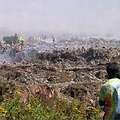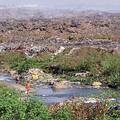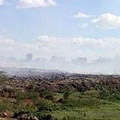 最新的一份研究指出,非洲最大的垃圾傾倒場之一,即位於奈若比的Dandora市立垃圾傾倒場,對城市的環境與附近孩童的健康已造成威脅。檢測結果發現,該區孩童血液中的鉛和其他重金屬的含量很高,而且他們也都同時遭受呼吸道疾病的侵襲,包括慢性支氣管炎和氣喘。
最新的一份研究指出,非洲最大的垃圾傾倒場之一,即位於奈若比的Dandora市立垃圾傾倒場,對城市的環境與附近孩童的健康已造成威脅。檢測結果發現,該區孩童血液中的鉛和其他重金屬的含量很高,而且他們也都同時遭受呼吸道疾病的侵襲,包括慢性支氣管炎和氣喘。
Dandora是一個低收入住宅區,位於奈若比市中心東側8公里處,是肯亞首都450萬人口所產生的固體廢棄物最主要的傾倒場。這個研究是由聯合國環境署所委託執行的,而環境署的總部就位於奈若比。
傾倒何種垃圾到這個場址完全不受限制。這個傾倒場散佈著各式各樣的垃圾,工業的、農業的、家用的,甚至是醫療廢棄物,包括使用過的注射器。塑膠、橡膠、被含鉛油漆處理過的木頭、含毒性化學物質的有害廢棄物……等,都可以在這個垃圾場找到。
奈若比河流經這個垃圾傾倒場,而有些垃圾就順勢流進河裡,這對垃圾場附近及河川下游的環境及居民的健康都造成威脅,因為這些居民可能會利用河水來灌溉食用作物或用於居家生活。
 每天都有許多人(包括小孩子在內)從附近的貧民窟和低收入住宅區來到這個垃圾場尋找食物、可回收利用的東西,甚至一些有價值的東西,可以賣了做為收入的來源。在他們撿拾垃圾的同時,也吸入由燃燒垃圾和甲烷所產生的有毒氣體。
每天都有許多人(包括小孩子在內)從附近的貧民窟和低收入住宅區來到這個垃圾場尋找食物、可回收利用的東西,甚至一些有價值的東西,可以賣了做為收入的來源。在他們撿拾垃圾的同時,也吸入由燃燒垃圾和甲烷所產生的有毒氣體。
這個研究檢驗居住在Dandora垃圾場附近,年齡從2到18歲不等的328位孩童。有一半的孩童,血液中的鉛含量等於或超過國際標準(每100cc的血液中10微克),甚至有2位孩童的鉛濃度分別是29和32微克。
環境署的執行長史坦納(Achim Steiner)說:「我們一開始就預期會有棘手且令人擔憂的發現,但真正的研究結果卻比我們原先想像的更為驚人!」
這些孩童一直暴露在污染物中,例如從土壞、水、燃燒垃圾發產生的重金屬或有毒物質。這也導致孩童們有可能得到呼吸道、腸胃甚至皮膚的疾病。暴露於高濃度的鉛會造成神經系統或腦的損傷,而鎘中毒則會造成內臟,尤其是腎臟的損害,甚至導致癌症。
 One of Africa's largest waste dumps, the Dandora Municipal Dumping Site in Nairobi, is a threat to the health of children living nearby and the city's environment, a new study shows. Tests found high levels of lead and other heavy metals in the blood of area children, who also suffer from respiratory diseases, including chronic bronchitis and asthma.
One of Africa's largest waste dumps, the Dandora Municipal Dumping Site in Nairobi, is a threat to the health of children living nearby and the city's environment, a new study shows. Tests found high levels of lead and other heavy metals in the blood of area children, who also suffer from respiratory diseases, including chronic bronchitis and asthma.
Dandora, located in a low-income residential area about eight kilometers (five miles) east of Nairobi center, is the main dumping site for most of the solid waste generated by the 4.5 million people living in the Kenyan capital. The study was commissioned by the UN Environment Programme, UNEP, which has its headquarters in Nairobi.
Dumping at the site is unrestricted. Industrial, agricultural, domestic and medical wastes - including used syringes - are strewn all over the site. Plastics, rubber and lead paint treated wood, hazardous waste containing poisonous chemicals were found on the dumpsite.
The Nairobi River passes by the dump and some of the waste makes its way into the river, which carries these environmental and health risks to communities near the dump and downstream who may be using the water for irrigation of food products and in their homes.
Every day, scores of people, including children, from the nearby slums and low-income residential areas use the dump to find food, recyclables and other valuables they can sell as a source of income. As they pick over the garbage, they are inhaling the noxious fumes from routine waste burning and methane fires.
The study examined 328 children from two to 18 years of age living around the Dandora waste dump. Half the children tested had blood lead levels equal to or exceeding the internationally accepted action levels of 10 micrograms per decilitre of blood, including two children with concentrations of over 29 and 32 micrograms.
UNEP Executive Director Achim Steiner said, "We had anticipated some tough and worrisome findings, but the actual results are even more shocking than we had imagined at the outset."
The children have been exposed to pollutants such as heavy metals and toxic substances through soil, water and smoke from waste burning with implications for respiratory, gastrointestinal and dermatological or skin diseases.
Exposure to high lead levels is also linked with damage to the nervous system and the brain, while cadmium poisoning causes damage to internal organs, especially kidneys, and cancers.
全文及圖片詳見ENS


